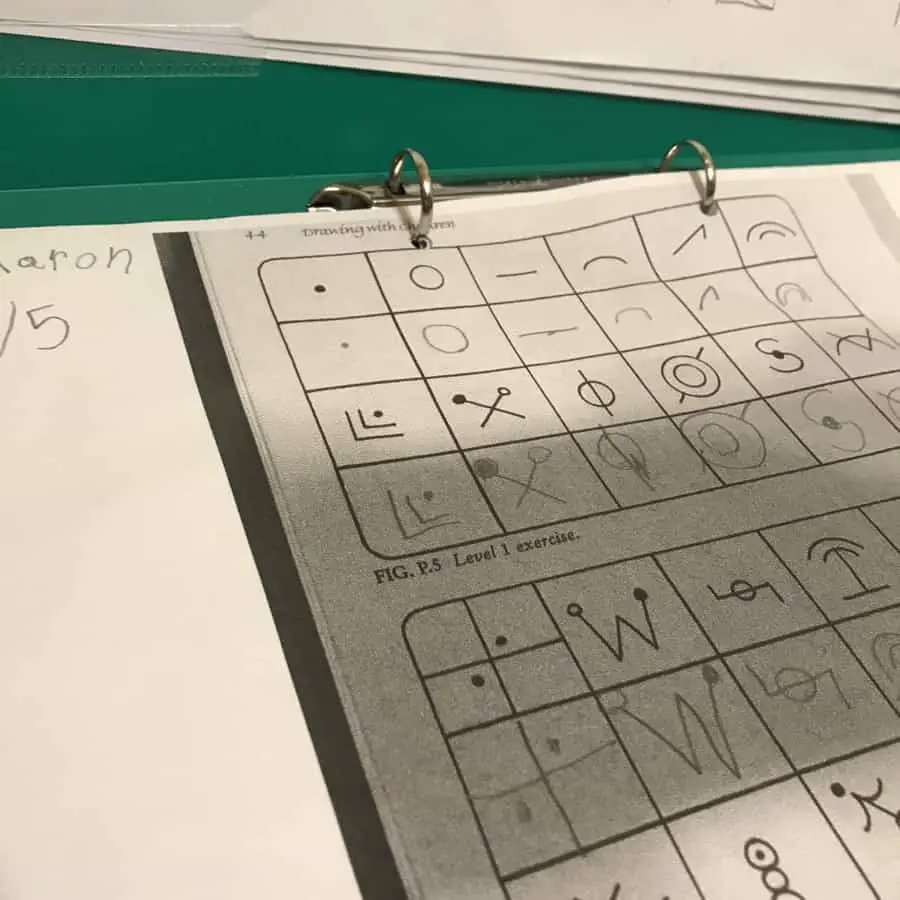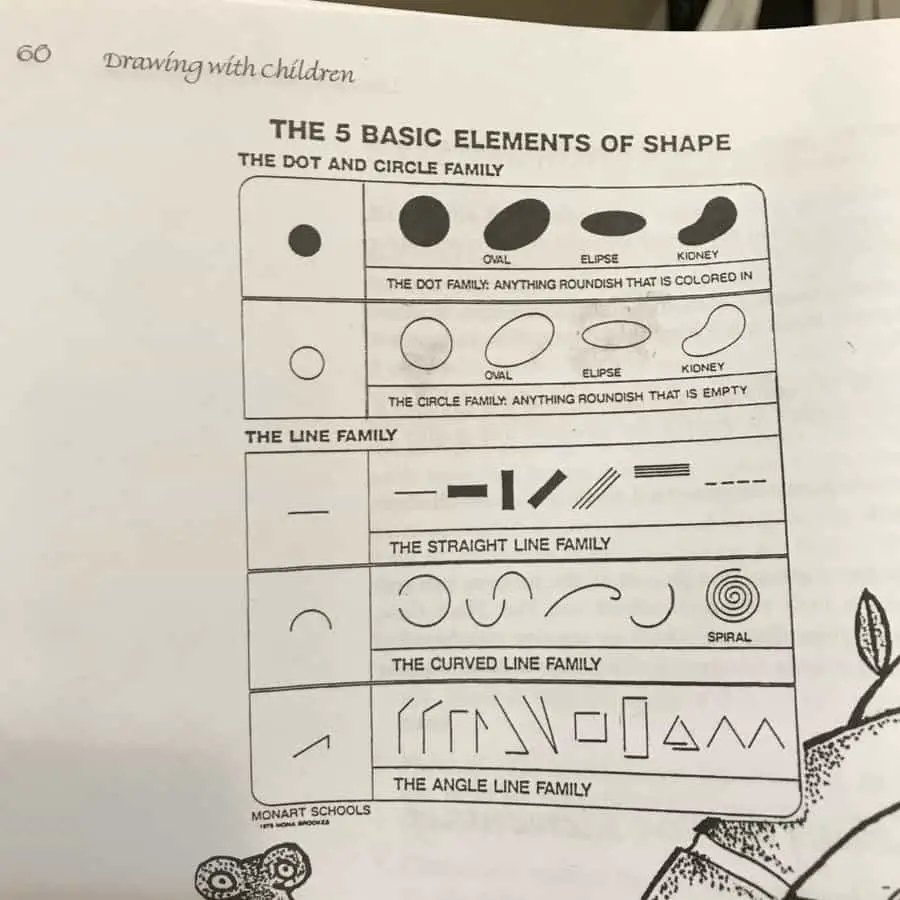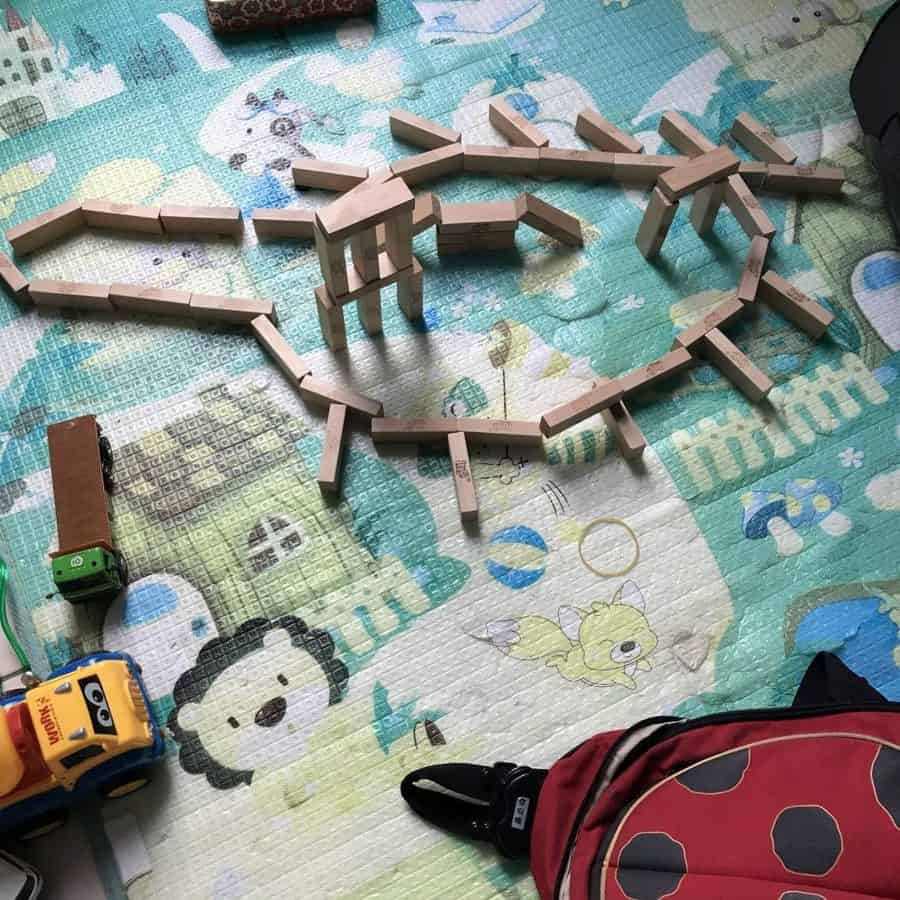This post contains affiliate links.
How to start art is something many parents wonder as well. Many parents are not artistic but still want to teach their children some useful art skills. We show you how to do it the easy way.
You should start art with learning how to draw in your homeschool. No matter what age a child can learn to draw and apply it to many areas of study. Drawing can be taught like any other subject and we show you an excellent way to teach the 5 basic shapes of all art.
Art in your homeschool can be made very simple and not messy at all. With the right techniques and curriculum we will show you the way to unlock your child’s creativity!
To start you only need some basic supplies like felt tipped pens and paper. Then you will begin to learn the “alphabet’ of drawing. The basic shapes that make everything we see around us. Then you will learn how to follow some simple principles to observe what you see and translate that to drawing. Once we found the method of drawing we were amazed at how easy it is. As young children, teens, or adults anyone can learn the basics of drawing with ease.
You will learn about the elements of shape. This is something novel to me and I have never heard about learning drawing through this method. Once you have these basic elements all of the activities begin with a warm-up to get you in the mood and relaxed to draw and to see. This way of drawing is to also train your child to relax and observe their environment and the objects they will draw. There are guides you can use to reference and they are not difficult. My child is only 5 at the time of writing this but he is learning it very easily. But most importantly he is eager to learn how to draw and it seems almost natural!
Begin art with a simple drawing test

We were excited when we first heard about a book called Drawing with Children, by Mona Brooks. It was like a breath of fresh air, sorry it was! What I was reading and doing made sense, and the most important thing for me was that the process makes sense! I am a man of science, yes my background is in Biology and unfortunately at times, I do think like a scientist. However in this case I think it makes perfect sense that a complex piece of art can be broken down into 5 elements of shapes. They are a circle, dot, line, curve, and angle. Yes, you have to see it first to believe. It sounds simple and it really is. Look around and you will see it.
Before you learn the shapes a simple drawing exercise for tests your levels. There are three levels and you will then have a good understanding of how much room you have to improve. This is a perfect activity that you can do with your child even if you don’t know how to draw. Why? Because it is really fun and it’s easy. I think as a beginner you can also use these exercises to practice your skills in the first week of this drawing course.
Learning the Basic Shapes of Drawing

Once you know your level then you will start to learn about the basic shapes you will find in all art. There are five basic shapes that make up everything you see around you. You will learn how to draw these five elements with ease. It really seems so simple at first. But this is the first time I’ve seen drawing taught like this. They break it down into elements. Many other topics also use basic elements. For example our English language is made up of 26 letters. There are also combinations for different sounds with consonants and vowels. Music has seven notes and then repeats at the octave. Engineering and science all have formulas to explain our surroundings.
This book breaks down learning how to draw into very manageable sections. Mona even provides us worksheets for learning about this. We simply copy them and print out and practice as much as necessary. I find this fun as well as I am learning with my son about art. Another point about drawing is that it is so essential and it is the building block for other forms of art. And it is not messy like when you are using water colors and paints. Drawing is relatively clean but still important to learn as you child grows up.
Relaxation for Preparing the Mind and Body for Drawing
When you think about it, the mind is controlling how you grip your pencil or pen and how you press it to the paper and draw something. It also makes sense to relax and close your eyes to put yourself in the mental state and mood for drawing. The book gives some wonderful techniques to teach you to prepare for art and clear your mind. It also explains how to relax your eyes so that you will have a better and clear vision for observing not only the subject of what you draw but also what’s on your paper.
Learn the elements of contour in art

The first lesson will begin with a warm-up activity to reinforce the shapes and help your child learn to observe objects and how to do it. These exercises will provide simple shapes to draw with the pens and you can also color them in with the colored markers. All of the exercises reinforce the understanding of each of the 5 shapes.
Learn how to use the elements of art
Next up is to learn and practice the shapes and how they go together. Much of the work, in the beginning, is using worksheets that allow us to copy, and mirror objects we see for practice. And then we also have exercises that we take simple objects from our home and use to draw. We apply the principles of the elements of shape in art to practice. It really works and if you do the classes 2 times per week, you will notice progress. The best part is you will have many pieces of art to put around your home or give to family and friends. Grandparents will love the art from their grandchildren.
I believe the main motivation for my kids is that as they learn each step they become aware of their skills and it builds their confidence. Having confidence is extremely important as they learn about art and other more complex skills. As Mona Brooks writes in her book that drawing is natural and has been used throughout history. It has been used to draw in caves and share stories about their history and great kings and warriors. Art and especially drawing is within all of us and with development we can excel at it.
Drawing Skills Can be Practiced Anytime and Anywhere

Apply art and drawing throughout your day for even more practice. While you are waiting for your dinner to be served in a restaurant, you can practice some drawing of the elements at your seat. You can encourage your child to take a sketchbook with them and sketch the objects in front of them or nearby. It becomes fun to draw for your child and they become even more skillful as they enjoy art and drawing what they see. Very often you will have restaurants provide crayons and a drawing or coloring table mat for kids, but we don’t need it. But it goes to show that art is all around us and it is a great form of learning and an excellent way to pass the time!
Drawing and art can also be incorporated and practiced during other lessons as well. For example, during a lesson on social studies, science or history, your child may want to not only take notes but draw or sketch a scene. This visual component can help them learn and recall the details even more clearly. It’s well documented that learning by sight, hearing and touch or multisensory immersion is an ideal way to learn.
Drawing your first objects
Learn how art can improve other subjects
Learning about arts in homeschool or any school is necessary not just to satisfy your credits for graduation or state requirements. It’s an important subject to bridge the child’s creativity into other subjects. Art education is so important that the United Nations organization, UNESCO has a week dedicated to the Arts. The 4th week of May is 2020 was dedicated to raising awareness of the importance of art for children’s educational sake.
Creativity builds the resilience we need in times of crisis. It has to be nurtured from the earliest age to unlock the imagination, awaken curiosity and develop appreciation for the richness of human talent and diversity. Education is the place where this starts.
Audrey Azoulay, Director-General of UNESCO on the occasion of the International Arts Education Week
The appreciation of the arts can also foster a better understanding of the world and cultural diversity. We always schedule time to visit any museum of fine arts whenever we visit a country. We are also blessed to live just a few miles down the street from a National Museum of Fine Arts. And also a massive library that is adorned with all kinds of art throughout the stacks of books.
See an informative video about the arts fostering an understanding of cultural diversity below.
Art is the Basis for Other Subjects
When I think back to my education I really can’t remember any art classes. I checked with my parents and they said I did have them. But they must have been so basic that it just wasn’t memorable. I also checked online with my old school if the subjects were still being taught. It is required for only 1 semester in elementary school, once in middle and 1 credit in high school. This seems too limited to me and no wonder I didn’t have much memory of it. In elementary, it is once per week for 40-50 minutes! This is almost not worth the time in my opinion. Once per week?? I don’t think much can be learned in such limited classes.
In Elementary, all K-5 students are enrolled in visual arts courses and receive 40-50 minutes once a week in a well-supplied art room or designated art-making area, Pinellas County Schools, Florida
Engineering And Design Need Good Drawing Skills
I took 1 drawing class in my university studies and I do remember that I had some decent skills. I drew some nice pieces and gifted my grandmother who proudly hung them in her living room. But I wish I had more classes since it would have helped immensely with some classes I took recently. I have taken some Design courses for industrial design and they require good drawing and sketching skills. 3D perspectives and 3-point perspective, all of which were new to me.
The professor, Hans Geiger, told me that in all of the product design and development courses he noticed those who had drawing skills could do much better in the class. Nowadays many students are able to use 3D and 2D software to draw. However, if they don’t have a sound understanding of drawing by hand, 3D drawing skills become very challenging. Hans is an old school designer who is also world-renowned for his team’s design work on the Suzuki Katana superbike in the 1980s. He can still draw by hand with such amazing skills!
Art Appreciation and Drawing for Life
Drawing is only the gateway for the appreciation and skills in art. It can lead to other useful studies in creative subjects that can help open a child’s mind. When your kid can draw what is in their mind and express their emotions through their artwork, it is an exhilarating experience for children.
“The painter has the universe in his mind and hands.”
Leonardo da Vinci
See how excited kids feel about art. One child even says that if they go to a school without art, they would feel very disappointed. And another girl says that it’s the only class where they feel free to do as they would like to do.
Art in Homeschooling May Lead to Music Appreciation
I’m lucky because I married a music teacher. Sabrina is a classic cellist and also plays the piano and ukulele. She sings quite beautifully and loud especially when I am not following her way! It is also shown that kids learning music by themselves or in a band will also be more proficient in other subjects. They learn discipline, dedication, teamwork and are more sensitive to their surroundings. One leading teacher adds extra music and art courses to his lessons. He believes there are not enough offered in his school.
“They are learning about things far beyond the art they study…he is not only learning to play the violin or clarinet, but he is also learning about discipline, responsibility, teamwork, sacrifice, practice, correcting mistakes, listening, and time management”,
Rafe Esquith.Teach Like Your Hair’s on Fire: The Methods and Madness Inside Room 56
This teacher and leading author based in Los Angeles said that at first he was concerned that students who attended band would miss his class 2 times a week and miss out and fall behind. However, he noticed that it was completely a myth. He soon realized that the students who were in music performed even better. They were keeping up with the work AND scoring higher on their tests. Joining a band also is one more opportunity for valuable team building and socialization skills for your child. As a homeschooler you need to provide your child with ample chances to meet and develop healthy and valuable friendships.
My wife is also a firm believer in music education as she also has a BS in Music Education. She will teach our son the basics as he grows up. I also learned the piano from here during the first year we were dating. I actually took lessons from here just to get to spend more time with her. But I realized that the practice required was also a valuable lesson for me.
Practicing for only 30 minutes per day would help me just be able to play the piano at a very basic level. If I wanted to get good, my wife told me that I would need to play at least 1 hour if I wanted to really play well. Practice really makes perfect, not just in music but in life! Art and music appreciation and education help to build your child’s future and valuable life lessons. Read this article about music in homeschooling we also wrote. It has helpful tips as well to build into your routine.
Dadcarestoo is a participant in the Amazon Services LLC Associates Program, an affiliate advertising program designed to provide a means for sites to earn advertising fees by advertising and linking to Amazon.com. We also participate in other affiliate programs which compensate us for referring traffic.

